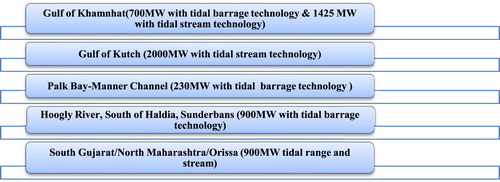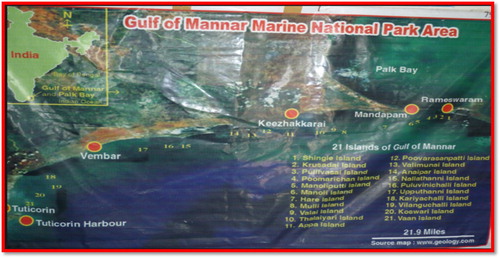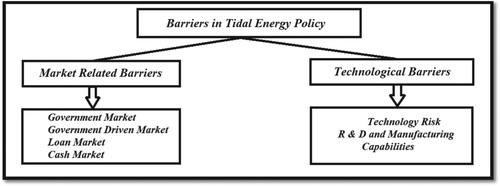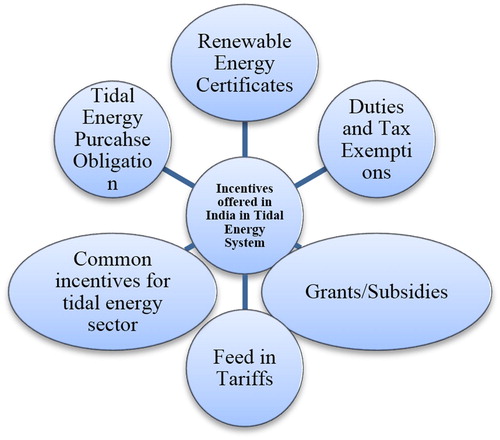ABSTRACT
India is the fourth biggest electricity consumer on the planet after the United States, China and Russia. India’s energy strategy concentrates on securing energy sources to address the issue of its developing economy. Service of New and Renewable energy has started an activity to track the advancing Tidal power administrative structure and build up an archive of data in a combined way. The reason for this paper is to show a refreshed diagram and status of tidal energy framework in India, notwithstanding assess the development space of individual sustainable power sources in the post-Statute time by considering the innovation advancement, local conditions and indigenous enterprises identified by the tidal energy framework. This paper includes a potential location for tidal energy generation in India as well as current scenario, grid parity and government support towards tidal energy in India.
KEYWORDS:
1. Introduction
Energy is the bit of the entire method of progression, advancement and survival of each and every living being and it accepts an essential part in the budgetary change and human welfare of the country. In all the nation condition change associated with non-sustainable power source usage has extended strain to deliver control of non-conventional energy source. In light of the dumbfound between stack demand and energy source confine required liberal advances infeasible power source developments have been impacted, colossal troubles to remain in making joined maintainable power source system (Bajpai and Dash Citation2012; Erdinc and Uzunoglu Citation2012). The outcomes from supportable power sources like sun fuelled, wind, hydro, tidal, biomass, geothermal change on an hourly, step by step and customary introduce. In this way, these sources are not proper for particularly controlling weights that require a uniform and persistent supply of information energy (Khare Citation2019). Melding distinctive feasible source sorts into the structure setup generally updates resource openness and the amassing of dispersed boundless power age mitigates at this very moment variability (Goedeckeb et al. Citation2007; Straatman and van Sark Citation2008). Operation from non-customary energy source usually requires battery supports to address the issue of supply fluctuations. Colossal overhauls may be possible by securing the energy as the hydrogen tank with the development of using batteries. In the midst of periods when the feasible resource outperforms the stack ask for hydrogen would be created through water electrolysis (Zhou and Francois Citation2009).
India is both a vital energy maker and purchaser and it is the ninth greatest economy on the planet, driven by a bona fide GDP improvement of 8.7% over the latest 5 years. In light of GDP data, it is recognised Indian economy has seen remarkable money related headway in the course of the most recent few years. The India was fifth greatest GDP advancement in 2010 in wherever all through the world (Borowy and Salameh Citation1996; McCormick Citation2007). A projection in the twelfth Plan report of the Planning Commission demonstrates that total family unit power age of 669.6 million tons of oil level with (MTOE) will be come to by 2016–2017 and 844 MTOE by 2021-22. This will meet around 71 for every penny and 69 for each penny of expected essentialness use, with the acclimate to be met from imports, foreseen to be around 267.8 MTOE by 2016–17 and 375.6 MTOE by 2021–22 (Goedeckeb et al. Citation2007). In the midst of the Eleventh Five Year Plan, around 55,000 MW of new age confine was made, yet there continued being a general energy insufficiency of 8.7 for each penny and a zenith absence of 9.0 for each group (Ravindran and Raju Citation1997; Doe Citation2010). Resources at the present time administered to energy supply are not sufficient for narrowing the opening between energy needs and energy openness [dod.nic.in] (Robins et al. Citation2015).
Wave and Tidal are two various ways to deal with removing energy from an advancement of water in the sea and oceans. Wave energy exists on account of the improvement of water near the surface of the sea. Waves are surrounded by turns blowing over the sea surface, and the water goes about as a conveyor for the electrical energy. The measure of energy in waves depends upon their stature and period (the time between dynamic apexes) (Khan et al. Citation2019). The yearly ordinary power per unit length of wave crest (e.g. 20–40 kW/m) is the fundamental point of how vivacious a particular site is. Tidal streams are caused by the rising and fall of the tides, which happen twice every day around the float. As the water streams every single through the estuary, it passes on energy. The extractable energy depends upon the speed of the spilling stream and the area caught. This resembles breeze control extraction, yet since water is significantly denser than air, a relative measure of energy can be expelled over tinier areas and at slower speeds (Amelio et al. Citation2012; Webb Citation1982).
The most reassuring and obvious kind of marine maintainable power source is the tidal power. It is nonpolluting, tried and true and obvious. Surely, even with its potential for obvious and reasonable power age with low visual impact, tidal power still records for only a little measure of a percent of the world’s mean power age. However the example is well ordered improving, with different tidal power plants being produced or organised along coastlines around the world. All inclusive, there is a set up example of tidal impacts being to a great degree productive. Nevertheless, steam turbines have not gained equivalent level of ground in view of their diverse quality. India has been looking force by methods for tidal power since the 1980s. There were wander reports masterminded handling this energy from the Panchapada River in Odisha and the Andaman and Nicobar Islands. The Ministry of New and Renewable Energy made an examination of the capacity of tidal energy in India, it is evaluated that the nation can pass on 7000 MW of energy in the Gulf of Khambhat in Gujarat, 1200 MW of energy in the Gulf of Kutch in Gujarat and around 100 MW of energy in the Gangetic delta of Sunderbans in West Bengal (Khan and Bhuyan Citation2009). A British tidal energy affiliation, Atlantis Resources, is relied on to set up a tidal power plant with the ability to make more than 250 MW in the Gulf of Kutch or Khambhat. India’s at first endeavoured to outfit tidal power for making power would be as a three MW plant proposed in the Durgaduani current in the Sundarbans delta of West Bengal. The Gulf of Kutch and Gulf of Cambay in Gujarat and Ganga delta in the Sunderbans, the world’s most prominent mangrove, are the three objectives seen as potential areas for tidal power age. There are diverse research papers identified by the tidal energy framework as of now displayed in various diaries. Tidal energy change framework in the terms of specialised and additionally conservative confinement. This paper introduces a far reaching survey of the present situation of tidal energy change advances and portrayed cost acquired in the advance of tidal energy ventures. Relative evaluation of headway of tidal and wave innovations in the middle of China and other Western Countries (Khare et al. Citation2018a, Citation2018b). In the recent scenario HOMER software is used for design and cost optimisation of tidal energy system in which tidal current and load is an input parameter and output is coming in the form of net present cost of the overall system.
2. Indian scenario of tidal energy
In the Indian context electricity generation through renewable energy system such as solar, wind and biomass system is very feasible and nowadays in India electricity production through tidal energy system increased tremendously. A lot of foreign investors want to invest in the field of tidal energy system in India and one of the British tidal associations set up 250 MW tidal power plant in the Gulf of Kutch to generate electrical power which is utilised in household, commercial and industrial application which is situated near the Gulf of Kutch. In the present renewable energy report sea shore of Kutch and Cambay are the world’s largest mangrove so that Indian government develop 3 MW tidal power plant near to the Gulf of Kutch and Sunderbans delta of West Bengal. The potential capacity of electricity generation through tidal energy system in India is 10,000 MW, in which highest potential site is the Gulf of Cambay has approximate 7200 MW and this is followed by the seashore of Kutch & the Ganga delta of Sunderbans. The potential electricity generation capacity of Kutch and Suderbans is 1300 and 600 MW respectively. Figure demonstrates Location astute tidal energy introduced limit in India. The total available capacity of wave energy in India along the 6000 Km of India’s float is surveyed to be around 40,000 MW based on preliminary evaluations.
This energy is anyway less elevated than what is accessible in more northern and southern expansions. In 2000 NIOT Goa, prompted a programme to lead look at on improvements for making splendid clean drinking water and energy of the sea. The goal was to make 2–3 lakh litres for consistently freshwater utilising the Low Temperature Thermal Desalination progressed by 1 MW OTEC Power Plant (Ravindran and Raju Citation1997). All things considered, it was dropped because of challenges in the establishments. In 2010 Kalpasar Tidal Power Project at The Gulf of Khambhat was perceived as a promising site for tidal power time by UNDP Expert. On Jan 2011, the area of Gujarat broadcasted plans to show Asia’s first business scale tidal current power plant; the state government grasped the progression of a 50 MW meander in the Gulf of Kutch. Table shows the Location keen Geographical condition for Tidal Power Station. None at the present time, anyway the India’s Ministry of New and Renewable Energy said on Feb 2011 that it might give cash related motivations to as much as 50 percent of the expenses for meanders wanting to demonstrate tidal impact. In 2014 Atlantis Energy proposed to present and make 50–200 MW Tidal stream based power plant in Gulf of Chambey (Barkin and Ferrandiz Citation2004; Barbarelli et al. Citation2014a; Barbarelli et al. Citation2014; Barbarelli et al. Citation2015).
Table 1. Location wise geographical condition of Tidal Power Station (Khare et al. Citation2018a, Citation2018b).
3. Potential location of India for tidal power generation
Gulf of Khambhat: To the generation of electricity through renewable energy system, it is necessary to determine pre-feasibility assessment of preferred location and if we want to generate electricity in India through tidal energy system so most preferred location is the Gulf of Khambhat which is also popular by the Gulf of Cambay in the state of Gujrat. Indian national institute of ocean technology recommended Gulf of Khambhat for tidal energy production in 2010 and area wise, which is 200 km long and it distribute to the south and west by 20 and 70 km respectively. These were seen by the analysts required to be the enlargement of the present day noteworthy conduits of the zone. Figure shows the potential location of India, which are utilised electricity generation through tidal energy system. The Gulf of Kutch is leading tidal energy generation site of India and followed by the Gulf of Khambhat, Sunderbans and Seashore of Maharashtra. The surveys were followed up in the next years and two pole channels of old streams were found amidst the Khambhat kept running under 20-40 m water profundities, at a parcel of around 20 km from the present day glide. One of the principal conflicts incorporating the Gulf of Khambhat is the dated piece of wood. Figures and demonstrates an area of the Gulf of Khambhat, Gulf of Kutch and Gulf of Mannar. Another questionable issue is the relics recovered from the site amid the different unearths. It is questioned that huge numbers of the things that have been distinguished as antiquities by the NIOT agents are really man-made. Rather, their manufactured nature is challenged and they are contended to be stones of common starting point (Saha et al. Citation2016;Kathiroli Citation2004; Khare et al. Citation2018a, Citation2018b).
Gulf of Kutch: The next potential site in India for electricity generation through tidal energy system is the Gulf of Kutch which is the part of Arebian Sea in the state of Gujrat, where the state of Gujrat always follow the concept of green technology and clean development mechanism. The gulf of Kutch is 100 km long and highest depth in the Gulf of Kutch is 123 m and this is the point which provides higher electricity generation through tidal or wave energy system. Marine National Park in the Gulf of Kutch is masterminded on the southern shore of the Gulf of Kachchh in the Devbhumi Dwarka District of Gujarat state, India. In 1980, a locale of 270 km2 from Okha to Jodiya was articulated Marine Sanctuary (Khare et al. Citation2018a, Citation2018b). A short time later, in 1982, an inside district of 110 km2 was articulated Marine National Park under the game plans of the Wildlife (affirmation) Act, 1972 of India. There are 42 islands on the Jamnagar float in the Marine National Park, the greater part of them enveloped by reefs [21].
Palk Bay Manner Channel: Besides of Gulf of Khambhat and Gulf of Kutch, another potential location in India is Pak way manner channel which is not long as such as other two but it is also capable to generate electricity in the range of 10–500 MW. It lies in between the coastline of India and Sri Lanka (Kardani and Yusufzai Citation2016). Due to the average tidal range and tidal current palk bay of manner is preferable location for hybrid conventional-tidal, solar-tidal and wind-tidal energy system for electricity generation. Table demonstrates normally happening streams along Indian coastline. Figures and indicates the tidal current variety in surmised 2000days in the Gulf of Khambhat, Gulf of Kutch, Gujarat and the suderbans (Kasilngam et al. Citation2016; Khare et al. Citation2018a, Citation2018b).
Table 2. Naturally occurring currents along Indian coastline.
4. India lacks a tidal energy policy
There are a number of feasible location in India to generate electricity through tidal energy system, but due to the limited tidal energy policy India does not follow the actual utilisation of seashore area and not achieve the target in the field of ocean energy system. The main limitation of tidal energy system is, its larger capital cost and highly moveable operation and maintenance cost. It is necessary to develop a solid move towards creating eagerness among renewable energy designers and receiving the acceptable attentiveness towards development of tidal energy as a power source. Despite the way that India can develop in excess of 8000 MW of intensity through tidal power, observe that the exercises which were masterminded before were left a direct result of high capital costs (Gianluigi et al. Citation2017). Prior to looking unlimited wellspring of energy, India needs to consider factors like the normal impact of these exercises on the natural network, the transmission necessities of the power from shoreline front districts to the populated central bit of the country and what’s more set up a strong tidal energy course of action to attract tourists to adventures (www.niot.res.in, dod.nic.in). The Figure shows barriers in tidal energy policy which are two types market related and other is technological barrier. In the market related barriers the government buys the electricity by the tidal energy system as a consumer and providing financial support for it. There is a lot of research are required in technical and design, prospectus of tidal energy system (Indian Wave Energy).
5. Grid parity of tidal energy in India
Grid Parity is the lean at which income of creating power from ocean energy produces control at a price that is equivalent to or not as much as the price of buying electrical energy from the conventional system. In perspective of the way that a consequence of the circumstance the correct position of ‘grid pricing’ differs from area to area as well as client to client and even day to day. Grid parity is exceptionally basic phrasing in the ocean energy framework and ideally ocean energy part, since the capital cost of tidal segment is to a great degree high in the current situation. India’s tidal power expenses could dive by in excess of 40 percent by 2025, enabling the business to go up against local oil and gas firms without the assistance of state endowments. That would empower tidal energy to end up a more reasonable choice to coal, which costs around 2 rupees a unit, in fuelling the Asia’s 3rd biggest economy and the globally 3rd vast carbon polluter. Under the Indian tidal Mission design, issued in 2017, India is to create 0.32GW of energy by 2024 and 0.9-GW by 2028 as a general venture of about USD70 billion. In the idea of a framework, equality India reaches in grid parity in the tidal energy framework in 2038 (Khare et al. Citation2013, Citation2018a).
6. Challenges to tidal energy system
When we want to install tidal energy system for power generation, then numerous issues confronting the development of the tidal current system. Overall, availability and failure rate are the noteworthy technical challenges due to the higher capital and operation & maintenance cost.
Other challenges include
Irregular supply – Due to the weather condition and uncertain rise & fall in tides, it generates irregular tidal energy and compensate such type of problem to install a large number of batteries to store tidal energy.
Cost – The capital, replacement and operation & maintenance cost of the overall tidal energy system is very large and this is a main drawback of tidal energy system in the Indian context.
The modifying of the biological community at the sound Damages like decreased flushing, winter icing and disintegration can change the vegetation of the zone and upset the equalisation. Like other sea energies, tidal energy has a few requirements that make it just accessible in a few locales. For a tidal power plant to create power viably (about 85% effectiveness), it requires a bowl or an inlet that has a mean tidal adequate (the contrasts among spring and neap tide) of 7 metres or above. It is likewise alluring to have semi-diurnal tides where there are two high and low tides each day. A torrent over an estuary is exceptionally costly to fabricate, and influences a wide territory – the earth is changed for some miles upstream and downstream. Numerous flying creatures depend on the tide revealing the mud pads with the goal that they can nourish. There are a couple of reasonable locales for tidal floods (Sharma Citation2013; Cohen Citation2009).
Tidal energy system only depends on the tidal current and due to this reason overall system only generate electricity 10 h of the day.
Conventional design of tidal turbine is not feasible, it is very harmful to fish and birds.
Construction cost is very high
Limited feasible location
The conventional barrage system is very expensive and they follow very slow processes.
Barrages affect fish migration and other wildlife – many fish like salmon swim up to the barrages and are killed by the spinning turbines.
The fish ladder system is never being 100% effective.
The tidal barrages may affect the tidal level and the variation in tidal level may affect steering, leisure, cause flooding of the shoreline and affect local marine life.
They must be based on sea coastlines, which imply that for networks which are far from the ocean, it’s pointless (Harries et al. Citation2006; Orekan et al. Citation2015).
7. Government support towards tidal energy in India
The government of India is starting behind schedule proclaimed, it will soon offer tidal energy reinforce in the country. In any case, this alternative energy presents a couple of disadvantages that ought to be kept an eye at first. Tidal energy is something a couple of countries are exploring making. In any case, at the show, in the pre-creative work sorting out, the innovative source of energy can price wherever flanked by Rs 16–35 for every electricity unit (Indian rupees). Figure indicates government, motivating forces for an Indian tidal energy system. Amazing that India, a country with such capacity of tidal energy still does not have a tidal energy system. As headways occur, it’s essential to set strong methodologies for most prominent clearness. The organisation should oblige the power made through this particular kind of energy source. In case the Indian experts need to create eagerness among fashioners, the underlying advance is setting up a strong approach. India’s cumulative possible concerning tidal power is colossal; it could convey in excess of 8000 MW of energy. A basic determination is that the best exercises were shut down in view of their high capital costs. Also, there are so far a couple of obstacles in the strategy for making tidal essentialness systems (Vijyalakshmi and Girish Citation2017).
In India the state government of Gujrat establishes first tidal power plant with the joint venture of the Atlantis resource corporation at the cost of 25 billion the location of the Gulf of Kutch with the capacity of 50 MW and it develop electrical energy through rise and fall of tidal current. The hardware has been transported in and work will begin at any point in the near future. We are anticipating Coastal Regulation Zone leeway from Ministry of Environment and Forests, which is normal soon’, includes Raisinghani. As per the Gujrat authorities, if this fifty MW plant is effectively dispatched, its potentially expanded to 250 MW. According to an investigation of the last 3 years led by the Resource Corporation of Atlanta and the government of Gujrat, the potential capacity of the Gulf of Kutch is 350 MW. As per the appraisals of the government of India, the potential capacity of tidal energy system is 9000 MW. This incorporates around 7500 MW in the Gulf of Cambay, 1100 MW in the Gulf of Kutch and 150 MW in the Gangetic delta in the Sunderbans district of West Bengal. The legislature should likewise give sponsorship to decrease the cost of bringing in wave innovation so purchasers can get the least expensive rate on per unit utilisation, he includes. The Gujarat government a year ago affirmed a 10 MW tidal energy plant proposed by Urja Global Limited in a relationship with a US-based organisation Ocean Energy Industries. Be that as it may, no date has been given for beginning the project yet. ‘The Ministry of New and Renewable Energy ought to set up an appropriate arrangement on tidal energy for the improvement of this division is fundamentally their duty’, says an authority of the GPCL, wishing obscurity. No designer will approach unless the strategy indicates guaranteed benefits, he includes. The elevating news today is that the lawmaking body is keen to benefit by tidal imperativeness. As shown by the Power Minister tidal systems require a 5-metre base tidal advancement. This proposes Maharashtra and Gujarat are the essential areas where control plants could set up. The Minister has moreover examined the limit of rooftop top sun based energy. In an offer to move it, the association ensured up to 30 percent sponsorship to pound the high beginning expense (Melikoglu Citation2018, www.ireda.gov.in, Pearce Citation2005; Sanchez et al. Citation2014).
A List of stakeholders involved in the development of technology at central and state level:
Various stakeholders are involved in the development of the marine technology at the central and state levels. The exhaustive list is mentioned below:
Research & Information Institutes like Indian Institute of Technology-Madras, National Institute of Ocean Technology, National Institute of Oceanography, Indian National Center for Ocean Information Services, Indian Ocean Global Ocean Observing System, Susi Global Research Center, Naval Physical & Oceanographic Laboratory, National Center for Earth Science Studies;
Educational Institutes/Universities like IIT–Madras, Kunjali Marakkar School of Marine Engineering, Cochin University of Science & Technology, Department of Meteorology and Oceanography, Andhra University, Department of Ocean Engineering & Naval Architecture, IIT Kharagpur.
Private sector developers involved in the development of ocean energy such as DCNS energy, Alstom India, EDF France and Atlantis, UK.
Others government, public and private agencies involved includes Ministry of New & Renewable Energy, Ministry of Earth Sciences, Indian Renewable Energy Development Agency Limited, AFD-France, and CRISIL.
8. Conclusion
Above discussion shows that condition of renewable energy sources such as tidal energy is satisfactory in India, but require additional attention for better development of tidal energy sources. For further development it is necessary to focus on specific technological system which requires better policy measurement and require more effort of government is necessary in that way. In India coastal region of Khambhat, Kutch, South Gujarat, Karnataka, Tamil Nadu, Andhra, Orissa has a great potential to develop electricity through tidal energy or wave energy system because all are location possesses sufficient amount of tidal current in the range of 1–4 m/s and kinetic energy having 85.3–5000 m2/W. In the present condition government of India support the concept tidal energy system and try to develop new mechanisms of tidal technique, tidal barrage system. So that According to above discussion India reaches ‘Grid Parity’ in tidal energy in 2035.
Disclosure statement
No potential conflict of interest was reported by the author.
References
- Amelio M, Barbarelli S, Florio G, Scornaienchi NM, Cutrupi A, Minniti G, Sanchez Blanco M. 2012. Innovative tidal turbine with central deflector for the exploitation of river and sea currents in on-shore installations. Appl Energy. 97:944–955. doi: https://doi.org/10.1016/j.apenergy.2011.11.044
- Bajpai P, Dash V. 2012. Hybrid renewable energy system for power generation in stand-alone application: A review. Renew Sust Rev. 16:2926–2939. doi: https://doi.org/10.1016/j.rser.2012.02.009
- Barbarelli S, Amelio M, Castiglione T, Florio G, Scornaienchi NM, Lo Zupone G, Cutrupi A. 2014. Analysis of the equilibrium conditions of a double rotor turbine prototype designed for the exploitation of the tidal currents. Energy Convers Manage. 87:1124–1133. doi: https://doi.org/10.1016/j.enconman.2014.03.046
- Barbarelli S, Amelio M, Florio G, Scornaienchi N M, Cutrupi A, Lo Zupone G. 2015. Transients analysis of a tidal current self-balancing kinetic turbine with floating stabilizer. Appl Energy. 160:715–727. doi: https://doi.org/10.1016/j.apenergy.2015.06.049
- Barbarelli S, Florio G, Amelio M, Scornaienchi N M, Cutrupi A, Lo Zupone G. 2014. Design procedure of an innovative turbine with rotors, rotating in opposite directions for the exploitation of the tidal currents. Energy. 77:254–264. doi: https://doi.org/10.1016/j.energy.2014.08.044
- Barkin YV, Ferrandiz JM. 2004. Tidal elastic energy in planetary systems and its dynamic role. Astron Astrophys Trans. 23:369–384. doi: https://doi.org/10.1080/10556790410001733800
- Borowy BS, Salameh ZM. 1996. Methodology for optimally sizing the combination of a battery bank and PV array in a wind/PV hybrid system. IEEE Trans Energy Convers. 11:367–375. doi: https://doi.org/10.1109/60.507648
- Cohen R. 2009. An overview of ocean thermal energy technology, potential market applications, and technical challenges. Proceedings Offshore Technology Conference; May 4–7; Houston, TX, USA.
- Erdinc O, Uzunoglu M. 2012. Optimum design of hybrid renewable energy systems: Overview of different approaches. Renew Sust Energy Rev. 16:1412–1425. doi: https://doi.org/10.1016/j.rser.2011.11.011
- Gianluigi LB, Benedetto N, Davide AG, Fabrizio C. 2017. How to handle the hydrogen enriched natural Gas blends in combustion efficiency measurement procedure of conventional and condensing boilers. Energy. 123:615–636. doi: https://doi.org/10.1016/j.energy.2017.02.042
- Goedeckeb M, Therdthianwong S, Gheewala SH. 2007. Life cycle cost analysis of alternative vehicles and fuels in Thailand. Energy Policy. 35:3236–3246. doi: https://doi.org/10.1016/j.enpol.2006.11.015
- Harries D, Mark M, Philip J, Chacko T. 2006. Hydro, tidal and wave energy in Australia. Int J Environ Stud. 63:803–814. doi: https://doi.org/10.1080/00207230601046943
- Indian Wave Energy. National Institute of Ocean Technology. www.niot.res.in/m1/mm1.html.
- Kardani HK, Yusufzai SK. 2016. Seasonal variation of oceanographic conditions along a marine national park and sanctuary, gulf of kutch Gujarat. J Exp Zool India. 20:879–884.
- Kasilngam K, Suresh GM, Krishnakumar S, Magesh NS. 2016. Trace element concentration in surface sediments of palk Strait, southeast coast of Tamil Nadu, India. Mar Bull. 3:500–508. doi: https://doi.org/10.1016/j.marpolbul.2016.06.051
- Kathiroli S. 2004. Recent marine Archaeological Finds in Khambhat, Gujarat. J Ind Ocean Archaeol. 1:141–149.
- Khan J, Moshref A, Bhuyan G. 2009. A generic outline for dynamic modeling of ocean wave and tidal current energy conversion systems. Institute for Electrical and Electronic Engineering, Piscataway, NJ, USA; p. 1–6.
- Khan J, Bhuyan GS. 2009. Ocean energy: global technology development status. Report prepared by Powertech Labs for the IEA-OES, Document T0104. Implementing Agreement for a Co-operative Programme on Ocean Energy Systems (OES-IA), Lisboa, Portugal.
- Khare V. 2019. Prediction, investigation, and assessment of novel tidal–solar hybrid renewable energy system in India by different techniques. Int J Sust Energy. 38:447–468. doi: https://doi.org/10.1080/14786451.2018.1529034
- Khare V, Khare C, Nema S, Baredar P. 2018a. Chapter 1 Introduction of tidal energy: tidal energy system, design control and optimization. Vol. 1. Cambridge: Elsevier; p. 41–114.
- Khare V, Khare C, Nema S, Baredar P. 2018b. Chapter 7 tidal energy assessment and economics: tidal energy system, design control and optimization. Cambridge: Elsevier; p. 331–394.
- Khare V, Nema S, Baredar P. 2013. Status of solar-wind renewable energy in India. Renew Sust Energy Rev. 27:1-10. doi: https://doi.org/10.1016/j.rser.2013.06.018
- McCormick M. 2007. Ocean wave energy conversion. Minola, NY: Dover Publications. ISBN-13:978-0-486-46245-5.
- Melikoglu M. 2018. Current status and future of ocean energy source: A global review. Ocean Eng. 148:563–573. doi: https://doi.org/10.1016/j.oceaneng.2017.11.045
- Orekan T, Zhao Z, Zhang P, Zhang J, Zhou S, Cui JH. 2015. Maximum lifecycle tracking for tidal energy generation system. Electr Power Compon Syst. 43:1182–1192. doi: https://doi.org/10.1080/15325008.2015.1010664
- Pearce N. 2005. Worldwide tidal current energy development and optimization for Canada’s Pacific coast. Int J Green Energy. 2:365–386. doi: https://doi.org/10.1080/01971520500287974
- Robins PE, Neill SP, Lewis MJ, Ward SL. 2015. Characterising the spatial and temporal variability of the tidal-stream energy resource over the northwest European shelf seas. Appl Energy. 147:510–522. doi: https://doi.org/10.1016/j.apenergy.2015.03.045
- Ravindran M, Raju VS. 1997. Wave energy: potential and programme in India. Renew Energy. 10:339–345. doi: https://doi.org/10.1016/0960-1481(96)00090-0
- Saha S, Burley SD, Banerjee S, Ghosh A, Saraswati PK. 2016. The morphology and evolution of tidal sand bodies in the macro-tidal Gulf of Khambhat, western India. Mar Pet Geol. 77:714–730. doi: https://doi.org/10.1016/j.marpetgeo.2016.03.028
- Sanchez M, Carballo R, Ramos V, Iglesias G. 2014. Energy production from tidal currents in an estuary: A comparative study of floating and bottom-fixed turbines. Energy. 77:802–811. doi: https://doi.org/10.1016/j.energy.2014.09.053
- Sharma R. 2013. Energy from ocean and scope of its utilization in India. Int J Environ Eng Manag. 4:392–404.
- Straatman PJT, van Sark WGJHM. 2008. A new hybrid ocean thermal energy conversion-offshore solar pond (OTEC-OSP) design: a cost optimization approach. Sol Energy. 82:520–527. doi: https://doi.org/10.1016/j.solener.2007.12.002
- US DOE. 2010. Energy efficiency and renewable energy marine and hydrokinetic database. Energy Efficiency and Renewable Energy, US Department of Energy, Washington, DC, USA.
- Vijyalakshmi S, Girish GP. 2017. Role of renewable energy in Indian power sector. Energy Procedia. 138:1073–1078. doi: https://doi.org/10.1016/j.egypro.2017.10.117
- Webb DJ. 1982. Tides and tidal energy. Contemp Phys. 23:419–442. doi: https://doi.org/10.1080/00107518208237094
- www.ireda.gov.in
- Zhou T, Francois B. 2009. Modeling and control design of hydrogen production process for an active hydrogen/wind hybrid power system. Int J Hydrogen Energy. 34:22–30. doi: https://doi.org/10.1016/j.energy.2008.10.004








